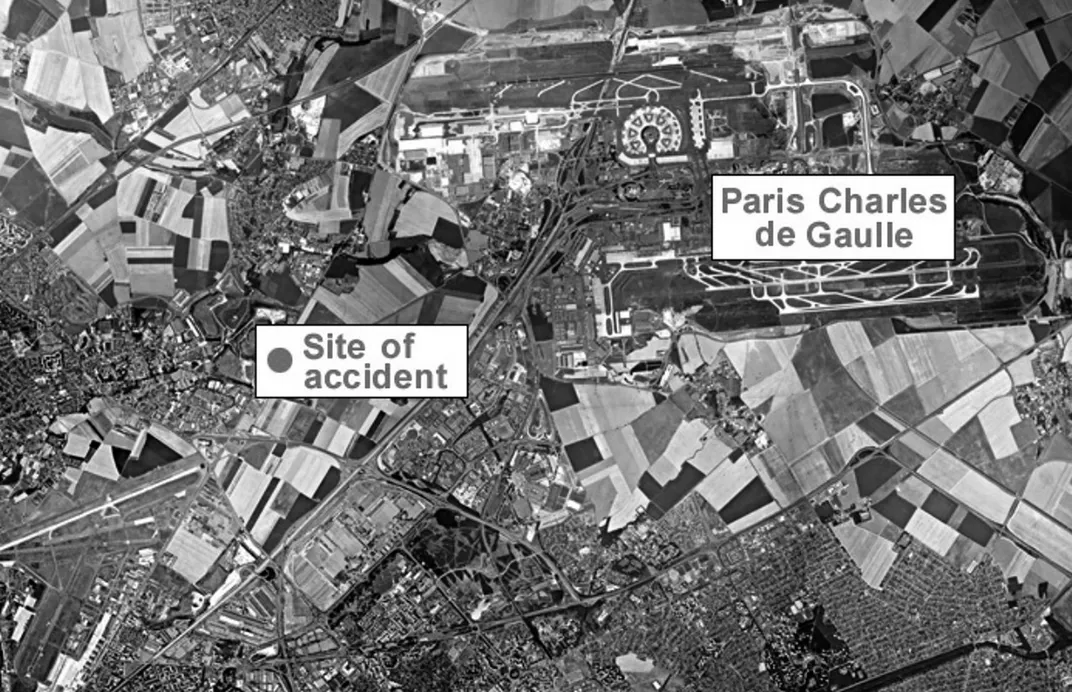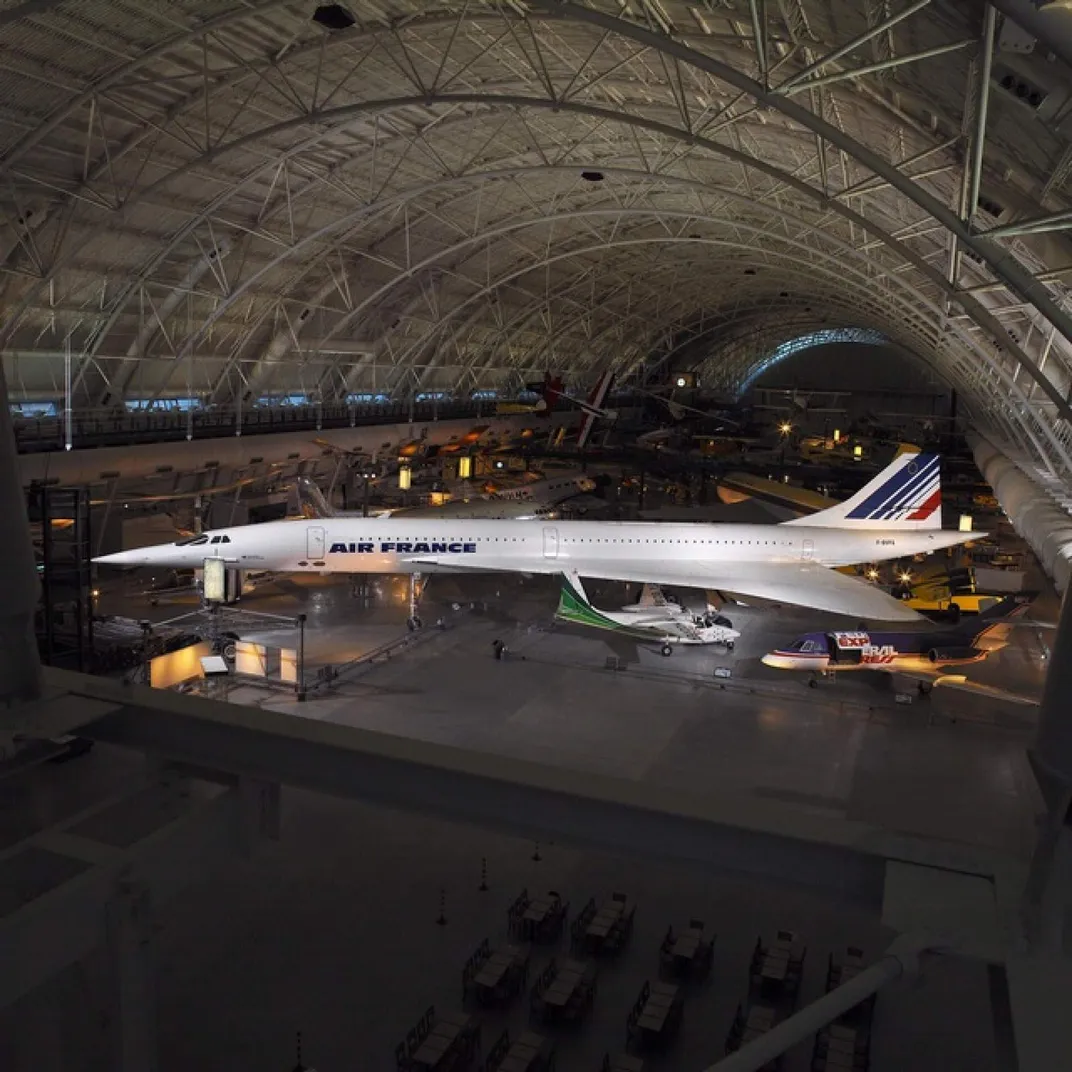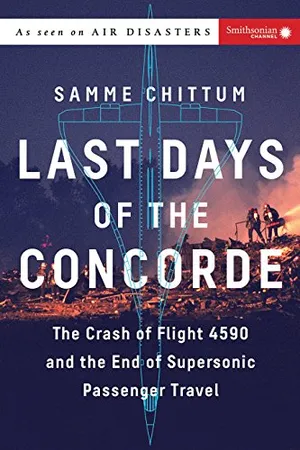This Freak Aviation Disaster Brought Supersonic Idealism Down in Flames
In a just-released Smithsonian Book, author Samme Chittum assesses the Concorde’s demise with the keen eye of a crime reporter
/https://tf-cmsv2-smithsonianmag-media.s3.amazonaws.com/filer/c9/c8/c9c8420d-09a3-45ea-9a9e-6c8c6afa1696/ap_00072501566.jpg)
After the physics of nuclear fission brought an astonishing and awful end to World War II, scientific advancement soared to the fore of national priority lists in countries across the globe. The atomic age was at hand, and science and security were inextricably intertwined. Yet in the space race born of the rivalry between the U.S. and the U.S.S.R., there was something more than military supremacy at stake—something more glamorous. In this “race,” which blossomed into a worldwide contest spanning all aspects of aviation, literal speed was paramount, and every day offered a fresh chance to build the sleekest, sexiest aircraft ever to grace the skies.
Few examples of Cold War aerodynamic elegance could hope to outshine the Concorde, the needle-nosed, delta-winged, ivory-white passenger plane developed jointly by France and England throughout the 1960s. The Concorde, lovingly dubbed l’oiseau blanc (“the white bird”) among French speakers, made its commercial airport debut in 1976, following a series of high-profile flight tests that captured the imaginations of millions.
Split between Air France and British Airways, the 14 Concorde aircraft to enter service were emblematic of space age bliss. Their slender bodies, equipped with a quartet of Rolls-Royce jet engines, were capable of delivering silky-smooth transatlantic junkets at twice the speed of sound. Three-hour-and-change Concorde flights from Paris to New York and vice-versa became the pinnacle of modern luxury. The round-trip price—as stratospheric as the aircraft’s cruising altitude—invariably dwarfed $10,000.
It is the Concorde’s abrupt and wholly unexpected tailspin into ignominy, propelled by the horrific crash of Air France Flight 4590, that lies at the center of the newly published Last Days of the Concorde, just out from Smithsonian Books and penned by career journalist Samme Chittum.
Last Days of the Concorde: The Crash of Flight 4590 and the End of Supersonic Passenger Travel (Air Disasters)
On July 25, 2000, the chartered Concorde jet, en route to America, crashed and killed all 109 passengers and crew onboard and four people on the ground. Urgent questions immediately arose. What caused the fire? Could it have been prevented? And, most urgently, was the Concorde safe to fly? Samme Chittum offers a fascinating insider's look at the dramatic disaster, the hunt for clues, and the systemic overhauls that followed the crash.
“When you understand how this plane caught fire, and how it burned to destruction,” says Chittum, “it’s very compelling—and to me, surprising.” It was a perfect storm of chemistry gone wrong, a disaster as remarkable in its own way as the Concorde’s typical grace in flight. “It was beautiful and horrible at the same time.”
The tragic day was July 25, 2000, the venue, northern France. At Charles de Gaulle airport, the Concorde aircraft responsible for Air France Flight 4590 glinted coolly near Terminal 2 as stormy weather gave way to afternoon sun. A bevy of German tourists, eager to see the Big Apple, mingled with their decorated captain in a private lounge before leisurely filing aboard the plane as 3:25 p.m. drew near.
What should have been an exquisite excursion through the firmament, however, never got far off the ground. As the Concorde’s mighty jet engines roared and Flight 4590 accelerated down the runway, one of its Goodyear tires encountered a piece of debris that had escaped the engine cowl of a Continental Airlines DC-10 as it took off just minutes prior. The sharp metal strip made mincemeat of the rubber, which was under considerable strain supporting the full weight of the notoriously heavy Concorde and its massive fuel supply, distributed across 17 tanks.
A large chunk of tread from the blown-out tire slammed into the underside of the plane’s left wing, sending an internal pressure shockwave propagating through the fuel in one of the primary tanks. When the pressure wave reached a weak point in the tank, it ruptured, causing a gout of atomized, highly flammable fuel to spew out towards the aircraft’s rear. Already past the velocity of no return for takeoff, pilot Christian Marty soon received a frightening alert from the control tower: “You have flames behind you.”

Investigators later concluded that a spark—likely triggered by stray wheel fragments contacting a brake fan—had ignited the gushing fuel. To make matters worse, the wheel rupture jammed the landing gear, rendering it impossible to retract the wheels for liftoff and creating a system of eddying air currents beneath the plane perfectly conducive to stoking the blaze.
The plane did make it off the runway, barely. But with its two portside engines gunked up to the point of uselessness and the back half of its fuselage engulfed in fire, the Concorde was fated for a grim end. Desperately attempting to maintain control of the vehicle as it hurtled in the general direction of another nearby airport at very low altitude (some 200 feet), the pilot found he had no way out. Utterly out of control, the Concorde alit in a fiery pancake landing on a hotel in the town of Gonesse, exploding in a spectacular mushroom of fire and smoldering metal and taking the (mostly vacant) hotel with it.
The inferno of the accident spared nobody on board. Four hotel workers who had the misfortune to be on skeleton crew duty were also wiped out, bringing the overall death toll to 113.
As a crime reporter of several decades and the daughter of a writer mother and engineer father, Chittum approached the episode from several distinct angles. “The Concorde disaster was very compelling to me,” she says, “in the overlay of the human stories, the trauma, the vast body of evidence that goes into analyzing the accident, and the work of the investigators, which is voluminous and very complex.”

Indeed, most of the above information was not at all clear to France’s BEA—analogous to America’s NTSB—when they embarked on their painstaking analysis of the tragedy. It was only through nearly half a year of round-the-clock investigations that the root causes of the destruction in Gonesse were settled on. The failure of two engines during the chain of events raised the red herring of an engine fire; BEA analysts had to use the airport’s runway as a physical timeline, piecing together every last bit of on-the-ground evidence, in order to show that what had actually doomed Flight 4590 was the ignition of a high-pressure fuel leak caused by the explosion of the compromised tire.
Concorde planes had experienced near-miss tire failures on dozens of occasions prior to the 2000 wreck, yet Air France had taken next to no steps to beef up the Concorde’s landing gear or protect its delicate delta wings from high-velocity shrapnel. It is this aspect of Flight 4590’s singular story that Chittum finds all too familiar—and frustrating.
“I think we need to listen to engineers and investigators,” she says, “and give them as strong a voice as the people who make the decisions about what’s profitable and will keep the airlines in the black.” Even today, she is sure, “vital, objective information about mechanical problems and maintenance problems is sometimes overlooked when it becomes too costly to address them.”
The Concorde crash of 2000 proved to be more or less the death knell of supersonic passenger planes. Flight 4590 wasn’t the last Concorde to fly—following the investigation, there was a reboot of the elite Concorde line introducing ultra-sturdy Michelin tires and reinforced wings, which was reasonably successful for a short time. But the aftertaste of the 4590 debacle never fully subsided, and the loud, expensive, fuel-guzzling Concordes seemed more and more like shiny white dinosaurs with each passing year. By 2003, their storied run was over.
Will supersonic passenger planes be making a comeback any time soon? There are entrepreneurs out there who think it likely, and the U.S. Congress is taking steps to authorize research into the development of a worthy successor to the “white bird” of Europe. Chittum is not so sure. Unless the nuisance of the sonic boom can be overcome somehow, she says, urbanites around the world are bound to reject any attempt at a Concorde 2.0. Bringing fuel consumption and price down to levels that people would be comfortable with these days will also be a tall order. The present-day air traveler is less romantic and far more pragmatic.
“When I look back at the mid-20th century, what they dared to do. . . It was a different mindset. Everything was possible,” Chittum says. “I don’t think we feel that way anymore about travel. I think we want to know if it’s safe.”
A Note to our Readers
Smithsonian magazine participates in affiliate link advertising programs. If you purchase an item through these links, we receive a commission.
/https://tf-cmsv2-smithsonianmag-media.s3.amazonaws.com/accounts/headshot/DSC_02399_copy.jpg)

/https://tf-cmsv2-smithsonianmag-media.s3.amazonaws.com/accounts/headshot/DSC_02399_copy.jpg)